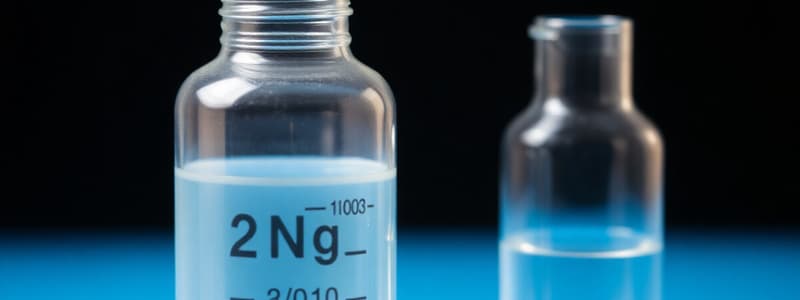Podcast
Questions and Answers
What is the symbol used to represent the Avogadro constant?
What is the symbol used to represent the Avogadro constant?
Na
What is the formula to calculate the amount of substance (n)?
What is the formula to calculate the amount of substance (n)?
n = N/NA
What unit is typically used to express molar atomic mass?
What unit is typically used to express molar atomic mass?
g.mol⁻¹
How do you determine the molar mass of a molecule?
How do you determine the molar mass of a molecule?
When determining the ionic molar mass, electrical charges are taken into account.
When determining the ionic molar mass, electrical charges are taken into account.
What is the relationship between the volumes of different gases under the same conditions of temperature and pressure, according to Avogadro-Ampère's Law?
What is the relationship between the volumes of different gases under the same conditions of temperature and pressure, according to Avogadro-Ampère's Law?
What does the molar volume (V_m) of a gas represent?
What does the molar volume (V_m) of a gas represent?
What is the formula for calculating the amount of solid substance (n_{solid}) from its mass (m) and molar mass (M)?
What is the formula for calculating the amount of solid substance (n_{solid}) from its mass (m) and molar mass (M)?
What is the formula for calculating the amount of liquid substance (n_{liquid}) from its volume (V_{liq}), density (\rho), and molar mass (M)?
What is the formula for calculating the amount of liquid substance (n_{liquid}) from its volume (V_{liq}), density (\rho), and molar mass (M)?
What is the formula for calculating the amount of gas substance (n_{gas}) from its volume (V_{gaz}) and molar volume (V_m)?
What is the formula for calculating the amount of gas substance (n_{gas}) from its volume (V_{gaz}) and molar volume (V_m)?
What happens when a solute is introduced into a solvent?
What happens when a solute is introduced into a solvent?
How is the mass concentration (C_m) of a dissolved chemical species defined?
How is the mass concentration (C_m) of a dissolved chemical species defined?
How is the substance concentration (C) of a dissolved chemical species defined?
How is the substance concentration (C) of a dissolved chemical species defined?
What is the relationship between (C_m) and (C)?
What is the relationship between (C_m) and (C)?
What is the formula to calculate the amount of substance to be taken to prepare a solution?
What is the formula to calculate the amount of substance to be taken to prepare a solution?
What is the formula to calculate the mass of compound to be taken to prepare a solution?
What is the formula to calculate the mass of compound to be taken to prepare a solution?
What is the recommended protocol for preparing a solution by dissolving a solid compound?
What is the recommended protocol for preparing a solution by dissolving a solid compound?
What is the formula to determiner the volume (V_{mp}) of stock solution to be taken to prepare a daughter solution?
What is the formula to determiner the volume (V_{mp}) of stock solution to be taken to prepare a daughter solution?
What does the chemical equation indicate?
What does the chemical equation indicate?
What do balanced chemical equations provide?
What do balanced chemical equations provide?
What is meant by the term 'limiting reactant'?
What is meant by the term 'limiting reactant'?
When is a reaction considered to have reached completion in terms of its reactants?
When is a reaction considered to have reached completion in terms of its reactants?
How is the maximal advancement (x_{max}) determined?
How is the maximal advancement (x_{max}) determined?
Flashcards
What is a mole?
What is a mole?
The amount of a substance containing the same number of entities as there are atoms in 12 grams of carbon-12. Equal to 6.022 x 10^23 entities.
What is molar atomic mass?
What is molar atomic mass?
The mass of one mole of atoms of an element in its natural state, typically expressed in g/mol
What is molar molecular mass?
What is molar molecular mass?
The mass of one mole of molecules of a given substance, calculated by summing the molar atomic masses of all atoms in the molecule.
What is Avogadro-Ampère's Law?
What is Avogadro-Ampère's Law?
Signup and view all the flashcards
What is molar volume?
What is molar volume?
Signup and view all the flashcards
What is mass volume?
What is mass volume?
Signup and view all the flashcards
What is density?
What is density?
Signup and view all the flashcards
What is mass concentration (Cm)?
What is mass concentration (Cm)?
Signup and view all the flashcards
What is concentration in quantity of matter (C)?
What is concentration in quantity of matter (C)?
Signup and view all the flashcards
What is limiting reactant?
What is limiting reactant?
Signup and view all the flashcards
Study Notes
Moles, Molar Masses, and Amounts of Substance
- One mole is equivalent to 6.022 137 x 10^23 entities, with 6.022 137 x 10^23 being Avogadro's constant (Nₐ).
- The amount of substance n (number of moles) of a chemical species X in a sample containing N elements is given by n = N/Nₐ.
Atomic, Ionic, and Molecular Molar Mass Determination
- The atomic molar mass of an element is the mass of one mole of atoms, noted as M, and is generally expressed in g/mol.
- Molecular molar mass refers to the mass of one mole of molecules.
- To determine molecular mass, sum the atomic molar masses of the atoms constituting the molecule, considering the coefficients in the molecular formula.
- Electric charges are not accounted for when determining an ionic molar mass.
Avogadro-Ampere's Law and Molar Volume Definition
- Equal volumes of different gases, measured under the same temperature and pressure conditions, contain the same number of molecules or atoms N, and thus, the same amount of substance n.
- The molar volume Vₘ of a gas is the volume occupied by 1 mole of that gas.
- All gases have the same molar volume Vₘ under the same temperature and pressure conditions.
- At 0°C, under 10.13 hPa: Vₘ = 22.4 L/mol; at 20°C, under 10 hPa: Vₘ = 24 L/mol.
Determining the Amount of Substance
- To determine the amount of substance n from a mass m, a liquid volume Vliq, or a gas volume Vgaz.
- n (solid) = m/M
- n (liquid) = p.Vliq/M = d. peau. Vliq/M; where p = m/V is the volumetric mass of the liquid, and d = p/peau is the liquid's density.
- n (gas) = Vgaz/Vₘ
Solutions and Concentrations
- A solution is formed when a solute (solid, liquid, or gas) is introduced into a solvent.
- The mass concentration Cm of a dissolved chemical species equals the ratio between the mass m of the introduced species and the solution volume V: Cm = m/V.
- The amount of substance concentration C of a dissolved chemical species is equal to the ratio between the amount of substance nX of the introduced species X and the solution volume V: C = [X] = nX/V.
- Relationship between Cm and C: Cm = CxM
Solution Preparation
- Calculating and preparing a volume V of a solution with a concentration in the amount of substance C through the dissolution of a solid compound.
- Amount of substance to be taken: n = CxV.
- Mass of compound to be taken: m = nxM = CxVxM.
- Introduce a mass m of solid into a volumetric flask of volume V, half-filled with distilled water. Dissolve the solid, complete with distilled water up to the calibration mark, and homogenize.
Preparing a Daughter Solution
- Calculating and preparing a daughter solution of volume V and concentration in the amount of substance C through dilution of a stock solution of concentration Cm.
- Volume Vp of stock solution to be taken:
- Method 1: CmxVmP = CfxVf, thus Vmp = CfxVf / Cm.
- Method 2: Determine the dilution factor F = Cm/Cf, then Vmp = Vf / F.
- Using a volumetric pipette (or graduated pipette or burette), take a volume Vmp of stock solution, which is introduced into a volumetric flask of volume Vf. Complete with distilled water up to the calibration mark and homogenize.
Chemical Reaction, Stoichiometry Table, and Molar Balance
- Chemical Equation, Reactants, Products, Adjustment
- Chemical equations indicate the proportions in which reactants disappear and products appear.
- Adjusted chemical reaction equations provide a balance in the amount of substance (number of moles) between the reactants consumed and the products formed.
Advancement Table Type
- Initial system: x = 0, n1 = 0.1, n2 = 0.6, 0, 0.
- Intermediate system: x, n1 - x, n2 - 3x, 2x, 3x.
- Final system: xmax = 0.1, n1 - xmax = 0, n2 - 3xmax = 0.3, 2xmax = 0.2, 3xmax = 0.3.
Maximum Advancement, Limiting and Excess Reactants, Stoichiometric Proportions
- When a chemical reaction is complete, the chemical system no longer evolves because the limiting reactant has completely disappeared.
- Advancement is then maximal x = Xmax, and the system is in its final state.
- Other unconsumed reactants are said to be in excess.
- To determine the maximum advancement Xmax, writing that each of the amounts of reactant in the final state is zero:
- n1 - Xmax = 0 or n2 - 3Xmax = 0 and keeping the smallest value of xmax then found; Here Xmax = 0.1 mol.
- When all reactants are completely consumed, the proportions are said to be stoichiometric.
Studying That Suits You
Use AI to generate personalized quizzes and flashcards to suit your learning preferences.




